Solar based electrical energy generation with spectral cooling
a solar energy and solar energy technology, applied in thermal-pv hybrid energy generation, pv power plants, radiation control devices, etc., can solve the problems of ineffective solar energy components (isec), poor electrical energy generation efficiency, and limited employment of remote workers, so as to achieve efficient electrical energy generation, reduce the effect of ineffective solar energy components
- Summary
- Abstract
- Description
- Claims
- Application Information
AI Technical Summary
Benefits of technology
Problems solved by technology
Method used
Image
Examples
Embodiment Construction
[0052]The instant solar conversion method and system makes advantageous use of the serially associated multijunction photocells as described above. These structures contribute importantly in the utilization of concentrated solar energy. The advantage of the series coupled solar cells is evidenced in FIG. 1. In that figure, the relative electrical output versus light intensity for a conventional photocell is represented at dashed curve 10. For such devices, as light intensity increases so does power output, but in a solar cell this results only in current increases. Increased current means increased heating and heating increases as the square of the current. Such increased heating results in lower efficiencies and lower efficiencies, in turn, result in lower power output for a given level of illumination. When losses in efficiency become greater than increases in solar intensity, then overall output peaks. In conventional solar cells, peak output is achieved at about 2.15 times norma...
PUM
 Login to View More
Login to View More Abstract
Description
Claims
Application Information
 Login to View More
Login to View More - R&D
- Intellectual Property
- Life Sciences
- Materials
- Tech Scout
- Unparalleled Data Quality
- Higher Quality Content
- 60% Fewer Hallucinations
Browse by: Latest US Patents, China's latest patents, Technical Efficacy Thesaurus, Application Domain, Technology Topic, Popular Technical Reports.
© 2025 PatSnap. All rights reserved.Legal|Privacy policy|Modern Slavery Act Transparency Statement|Sitemap|About US| Contact US: help@patsnap.com



